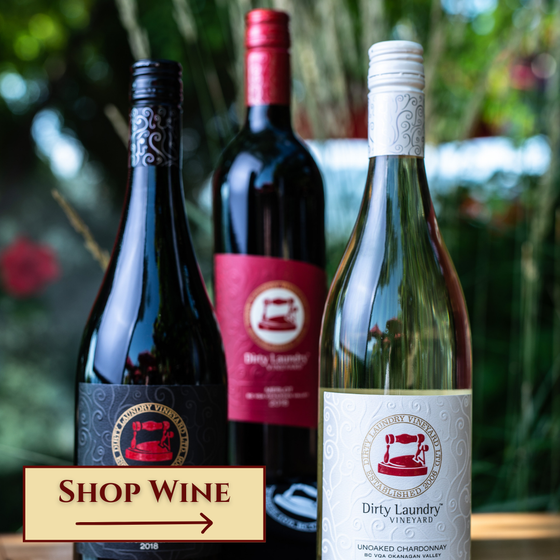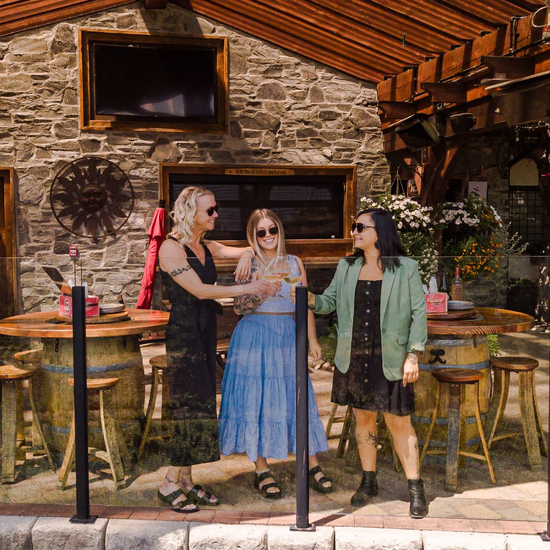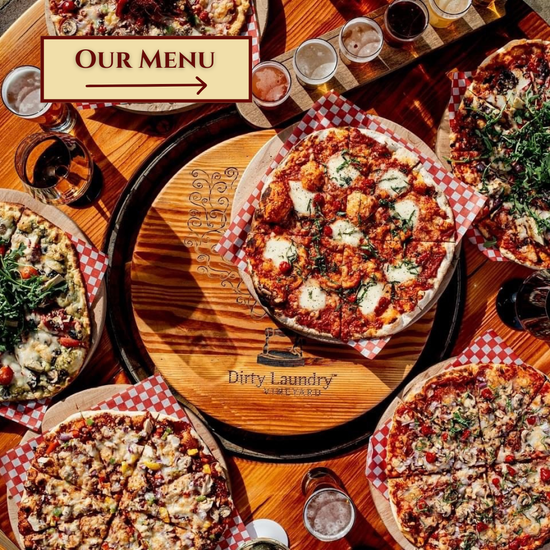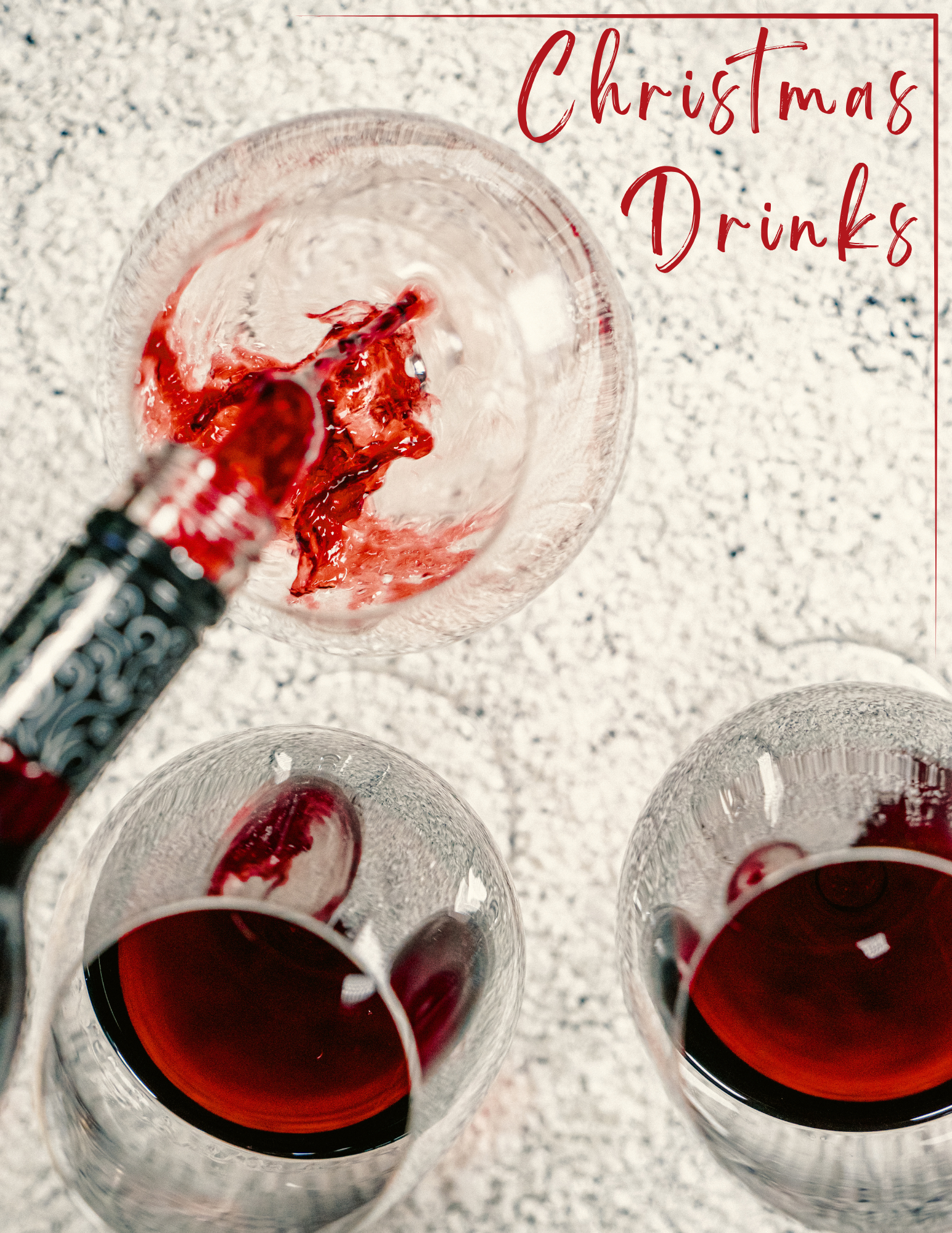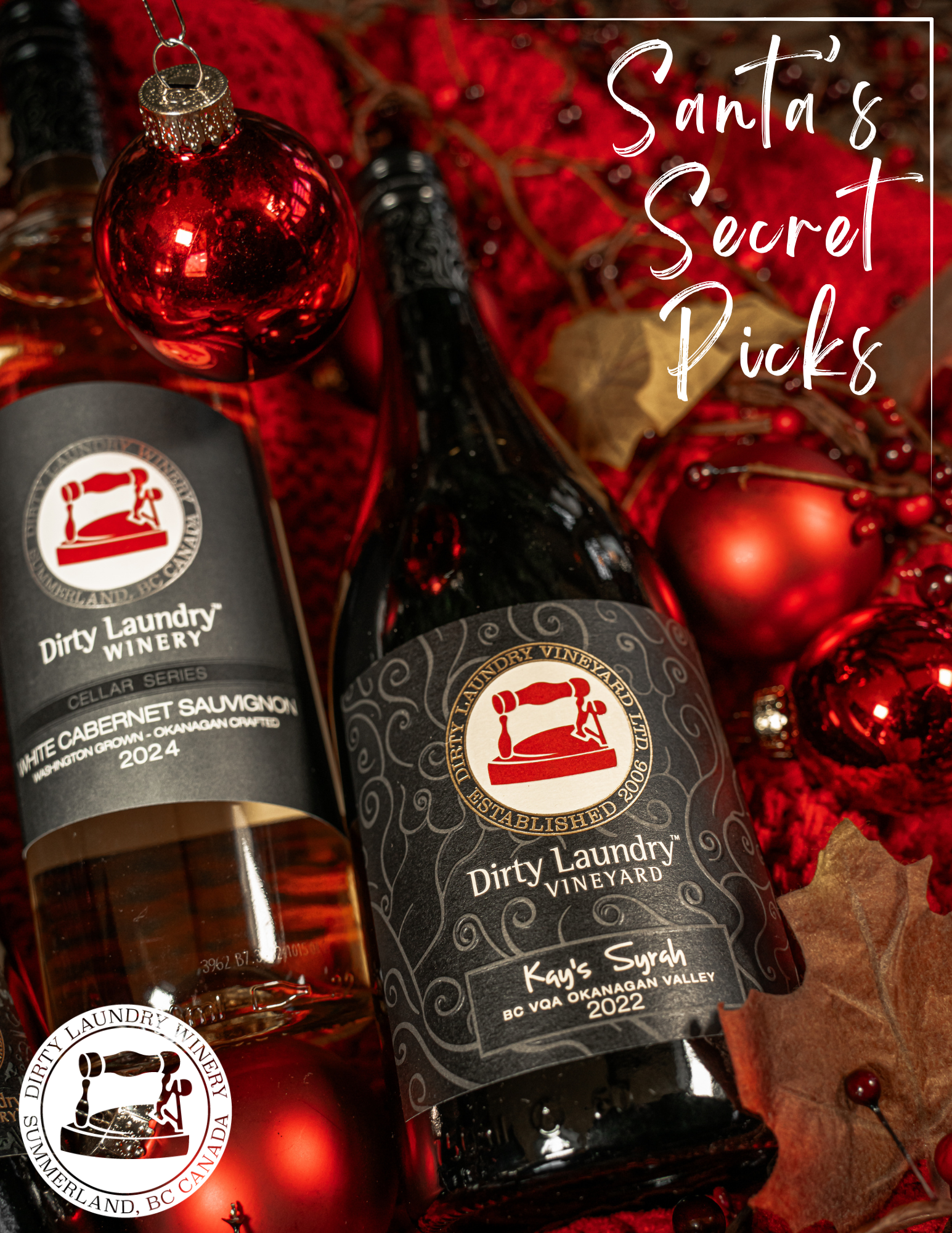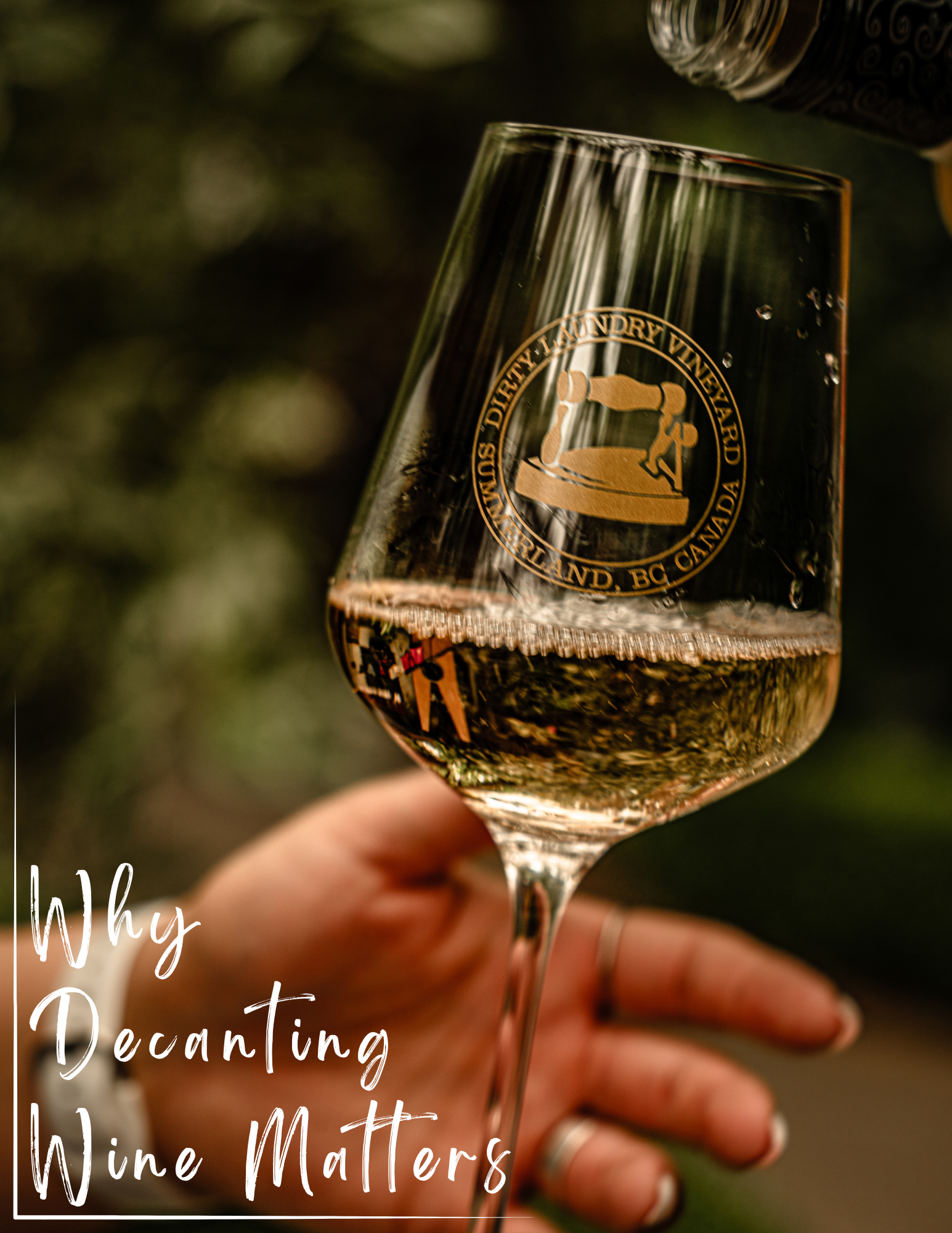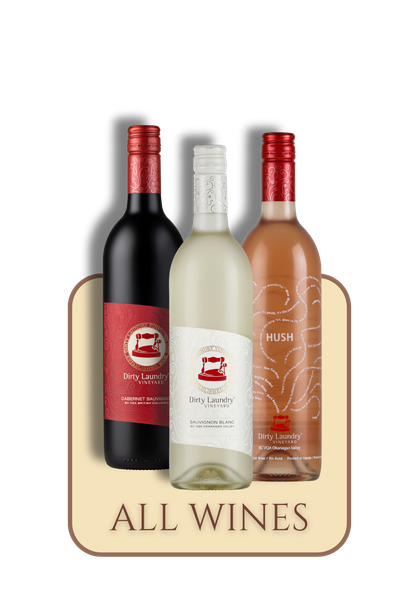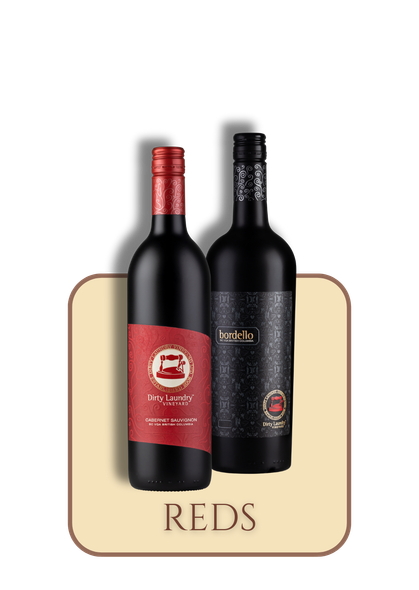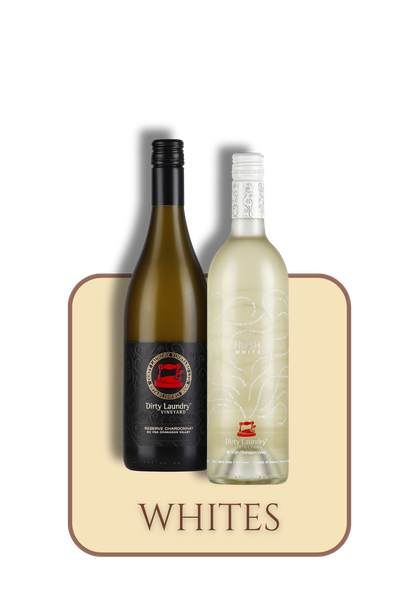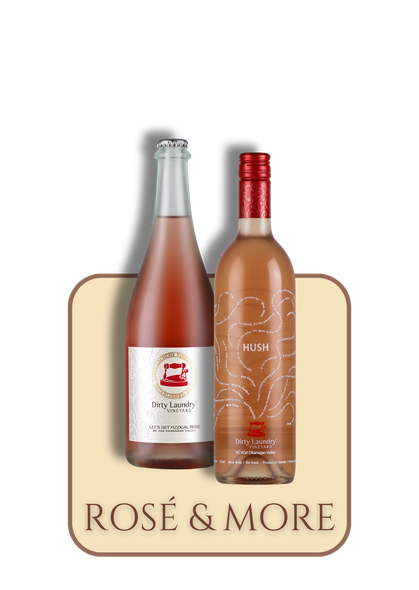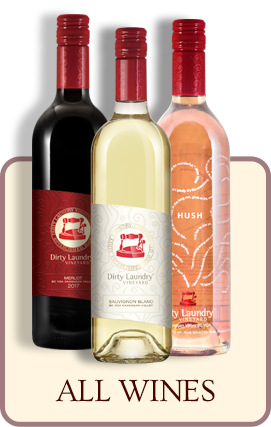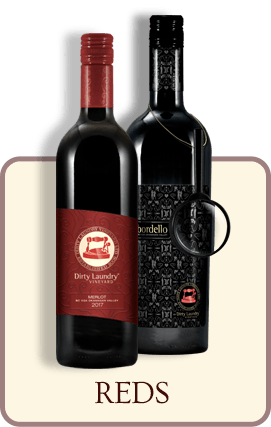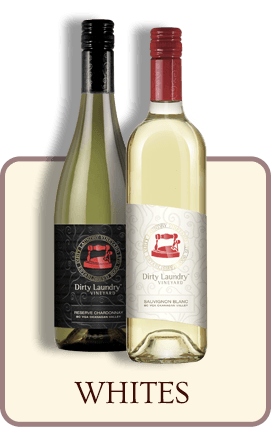Summerland’s Best Kept Secret & Wine Experience Destination
From grape to glass, shop online for our award-winning BC wines and join our Wine Club for insider access and benefits.
Visit Us
Enjoy
award-winning wines in our tasting bar, open daily until 4:00 pm. Walk-in only.
Wine Shop Hours:
Monday to Sunday: 11:00AM - 4:00PM
Red Iron Grille Hours:
Closed for the season.
Tasting Bar closes daily at 4:00pm.
Walk-in Only
We look forward to seeing you!
Follow Us On Instagram
From all of us at Dirty Laundry Winery, we want to wish you a very Merry Christmas and the happiest of holidays!!
However you celebrate, wherever you are, we hope your season is filled with joy, good company, and a glass of something delicious.
We’re so grateful for every visit, every shared moment, and every bottle enjoyed this year. Our community means the world to us, and we feel incredibly lucky to be part of your celebrations and traditions.
Here’s to rest to all the exciting things coming in 2026. We can’t wait to share the new year with you!
Happy Holidays from our DLW family to yours🎄🥂
•
•
•
#happynewyears #happyholiday #merrychristmas #christmas #winesofbc
With Christmas right around the corner here is a quick holiday reminder: Tomorrow is our LAST day open before we close for the holidays. We will be closed from December 21st to January 6th. If you need wine, gifts, or just want to pop in and say hello before we sign off for the season, we’d love to see you! 🍷
Don’t forget we have partnered with Flambé for an at home Christmas holiday bundle! If you still need to order your holiday meal, there’s still time… but availability is very limited. Check out our bio for more information!
Pickup Details:
📍 Flambé At Home (#101–13219 Victoria Rd. N, Summerland)
⏰ December 24th — Anytime between 9:30am and 3:00pm
Thanks for supporting local this season. We can’t wait to see you before we wrap up for the holidays!
•
•
•
#ShopLocal #DirtyLaundryWinery #SummerlandBC #HolidayHours #FlambeFeast #ChristmasDinner #SupportSmallBusiness
Christmas is better with the perfect drink in hand! From sparkling sips on Christmas Eve to cozy mulled wine afternoons and indulgent nightcaps by the fire, we’ve curated festive drinks for every holiday moment.
Whether you love it bubbly, spiced, or smooth, there’s a Christmas cocktail (or wine) waiting for you. Want to read more? Check our link in bio to read our December blog! ❄️🍷
•
•
•
#ChristmasDrinks #HolidaySips #FestiveCocktails #WineLovers #HolidayEntertaining #ChristmasCocktails #SipTheSeason #MulledWine #MerryAndBright #WineTime #HolidayHosting #CheersToChristmas #SeasonalSips #WinterCocktails
✨5 Days Left. 5 Wines.✨
The grand finale of Red Iron Days is HERE!
Only a select lineup is on sale, and trust us, you’ll want to check these out. Tap the link in bio to visit our Special Offers page and shop the final featured bottles!
Library Wine Alert:
Since releasing these same wines this morning, our 2020 Gamay (a library wine I might add), is already down to less than 2 cases!! If you’ve been waiting for something rare, this is your moment. Once it’s gone… it’s gone for good.
Missed our sale announcement email this morning? 😳 Make sure you’re signed up for our newsletter so you never miss a drop, a deal, or a delicious surprise again.
•
•
•
#RedIronDays #FinalFive #WineSale #LibraryWine #2020Gamay #HolidayShopping #ShopLocal #WineryLife #DirtyLaundryWinery #winesofbc #DirtyLaundryWinery #snow #season #christmas #CheersToThat #gamay #library #supportlocal
Holiday Shipping Alert! 📦🎄
Want to make sure your favourite wines arrive in time for the holidays? Here are our recommended order-by dates for pre-holiday delivery:
* Atlantic Canada: Order by December 5th
* Ontario/Quebec: Order by December 5th
* Prairies: Order by December 12th
* British Columbia: Order by December 16th
*These dates are estimates provided by our third-party couriers. While we’re always happy to help communicate with them, we can’t guarantee exact delivery times or unexpected delays.*
✨Don’t wait! Order now and relax into the holiday season! A glass of DLW in hand makes everything merry & bright. Red Iron Days is happening right now! Today’s 4 featured wines are only on sale until midnight… and new wines drop tomorrow.
Shop today’s lineup before it’s too late!
•
•
•
#HolidayShipping #RedIronDays #WineryLife #HolidayGifting #CanadianWine #ShopEarly #DirtyLaundryWinery #christmas #holidays #supportlocal #winesofbc #sunmer #winter #santa #gifts #gifting
Our Red Iron Days just got sweeter!🍪
Receive a free DLW Red Iron cookie cutter + a holiday recipe with every order! Made for holiday baking, wine sipping, and creating the best kitchen memories!
And yes… our 10-day sale is still going strong! Snag your treats (and your wines!) before they’re gone.
Limited supply.
•
•
•
#RedIronDays #HolidayBaking #WineryLife #CookieSeason #FreeGift #ShopLocal #winesofbc #supportlocal #christmas #holiday #cookiecutter #rediron #2025 #season #snow #winter #wine
🎉 RED IRON DAYS ARE HERE! 🎉
10 days. HUGE savings. Online only.
Are you ready?!
We’re kicking off the holiday season with our BIGGEST sale ever! Daily deals, surprise wines (yes, even hidden library drops 👀), all online merch on sale, and a FREE DLW cookie cutter + recipe with every order. While supplies last!
Holiday shopping madness starts NOW. Tap the link in bio to start shopping, and check your inbox every day for the next surprise!
•
•
•
#RedIronDays #WinerySale #HolidayDeals #WineLovers #ShopSmall #SipSipHooray #HolidayShopping #StockingStuffers #Cheers #winesofbc #supportlocal #blackfriday #cybermonday #christmas
Holiday wine shopping made easy!🍷
Our limited-time Holiday Bundles are 25% off — the perfect gift, party pick, or treat-yourself trio. Please note: No additional discounts are eligible to be applied.
And if you want your wines to arrive in time for the festivities, here are the recommended order-by dates:
📍 Atlantic Canada: Order by, Dec 5th
📍 Ontario/Quebec: Order by, Dec 5th
📍 Prairies: Order by, Dec 12th
📍 BC: Order by, Dec 16th
These dates come from our couriers and aren’t guaranteed, so don’t wait! Shop now, sip later, and keep the holidays merry, bright, and delicious🎁🍷
•
•
•
#DirtyLaundryWinery #HolidayBundles #WineLovers #CanadianWine #BCWine #HolidayGifts #WineGifts #SipSipHooray #HolidayCheers #WineryLife #WineDeals #ShopSmall #FestiveSips #WineofBC
We’re now open from 11:00AM – 4:00PM, seven days a week! We are ready to pour your favourite wines all cozy season long!
Our Red Iron Grille is now closed for the season, and we want to extend a massive thank you for all the love and support this year. It’s been an incredible season, and we can’t wait to welcome you back next year! ❤️
Please note: We’ll be closed Tuesday, November 11th in observance of Remembrance Day.
Here’s to cozy sips, good company, and a wonderful cozy season ahead! 🥂
•
•
•
#hours #summer #supportlocal #summerland #winecountry #sipandstop #winesofbc #canada #fall #new #winter
Guilty as charged… of pairing candy with wine🍷🍫 We hope everyone had a spooky, safe, and fun Halloween!
Here’s to a little mischief, a lot of laughter, and the best kind of pairings. The ones you can sip and savour.
•
•
•
#WineNot #HappyHalloween #WineAndCandy #HappyHalloween #GuiltyAsPoured #SipSipHooray #WineryLife #TrickOrTreatYourself #SpookySips #WineNot #CheersToThat #SweetAndSpooky #WineTime #HalloweenVibes #WineLovers #FallSips #WineryFun #winesofbc #supportlocal #shoplocal
Whisper, whisper… the rumours are true, our award winning patio is closing for the season on October 26th... I know we can’t believe it either!
No matter what, come join us this week for one last hooray on one of our town’s favourite award-winning patios! It’s your last chance to sip, snack, and soak up the patio vibes!🍷🍕
Don’t worry, our wine shop is open year round! You’ll be able to cozy up inside our wine shop and enjoy a wonderful tasting at our bar!
•
•
•
#WhisperWhisper #PatioSeason #LastCall #FallVibes #CozySeason #WineLovers #WineTasting #WineShopVibes #RaiseAGlass #PizzaAndWine #Foodie #SipAndSnack #PatioVibes #CheersToThat #winesofbc #supportlocal
Pucks, Pride, and Pinot Gris!🏒
It’s Summerland Night in Penticton and we’re cheering on the Penticton Vees as they hit the ice this Friday, October 24th at 7PM!
We’ll be sampling your favourites prior to the game. So come grab a sip, find your seats, and cheer on your favourite home town team! Let’s show our Summerland spirit and fill the stands with blue, white, and good vibes! Head over to our bio to grab some tickets! 💙🤍
•
•
•
#GoVees #SummerlandNight #PentictonVees #OkanaganWine #LocalLove #HockeyNight #winesofbc #supportlocal #pride #summerlandpride #DLW #wine #hockey #vees
We are so honoured to share that not one, but three of our wines have made it into the prestigious 2025 BC Top 50 list! 🍇🍷
Seeing so many incredible wineries across the province share their wins fills us with awe and gratitude for the beauty and talent that BC wine country offers. We are proud to be part of this community and to celebrate alongside such inspiring peers.
Today we celebrate these award winning wines:
🏅 2024 Reserve Chardonnay
🏅 2023 Cabernet Sauvignon
🏅 2024 Reserve Rosé
This recognition means the world to us, and it wouldn’t be possible without the passion of our winemaking team and the support of our incredible community. Here’s to raising a glass together! 🥂
•
•
•
#wineaward #cheerstoanotheryear #winelovers #winecelebration #BCWine #BCWineCountry #BCTop50 #DrinkLocal #OkanaganWine #SupportLocalWineries #ChardonnayLovers #CabSauv #RoséAllDay #ReserveWine #WineTasting
Ever wondered why sommeliers pour wine into those fancy glass vessels? It’s not just for show, decanting unlocks richer aromas, smoother flavours, and a better overall sip.
From bold reds to elegant whites, a little air makes a big difference. Curious how to do it right? 🍇
Do you want to learn more? Find our October Blog in our bio!
•
•
•
#WineLovers #WineTips #DecantingWine #WineEducation #WineExperience #SipInStyle #WineAndDine #WineLife #WineTastingTips #ElegantLiving #RedWineLove #WineCulture #FoodAndWine #SipSavorRepeat #FineWine #bcwine #bcwinecountry
It’s finally here—Oilers Home Opener night! 🏒
The Battle of Alberta kicks off as the Edmonton Oilers face their biggest rivals in a classic showdown to start the season tonight.
We’ve been keeping quite the secret… 👀 Some of you may have spotted our fancy new Oilers jersey hanging in the wine shop. For those who haven’t, the secret is out—we’re officially partnering with the Edmonton Oilers again this season!💙🧡
We couldn’t be more excited to be part of the action and look forward to serving you at Rogers Place all year long. Here’s to great hockey, unforgettable moments, and raising a glass to the oilers! (Even if they aren’t your team 😉)
•
•
•
#LetsGoOilers #BattleOfAlberta #HomeOpener #oilcountry #bcwine #winesofbc #edmontonoilers #edmonton #okanagan #partnership #hockey #NHL #supportlocal #shoplocal #bc
Forecast shows: Patio season is still here☀️
Our tasting room & wine shop are open year round, but our patio will come to a close on October 26th! Come soak up the sun while it lasts! The pizzas are hot, the wine is flowing, and we’d love to raise a glass with you🍷
•
•
•
#wine #winelovers #winetime #winetasting #wineshop #cheers #pizzalovers #foodie #eats #drinklocal #savorlife #patioseason #patioseasonisnotover #fallvibes #sunnydays #octoberfun #supportlocal #winerylife #smallbusinesslove #gatherhere #bcwine #winesofbc
POV: you’re sipping in the Okanagan and the vibes are widescreen only🎥
•
•
•
#WineTime #WineryVibes #SipSipHooray #WineNot #InVinoVeritas #DrinkBetterWine #WineLovers #JumpingOnTheTrend #TrendySips #WideScreenWine #SipTok #VinoViews #5120x1080 #bcwine #okanaganwine #winetasting #okanaganvalley #supportlocal #shoplocal
Meet our 2025 Harvest Crew! 🍇
Our Winemaker Mason, Assistant Winemaker Chris, and Cellar Hand Luke are the trio behind making DLW wines so special! Of course, this is only part of the story. Our full crew is far too many hardworking individuals to capture in one photo. Each person plays a vital role in making Harvest 2025 possible.
Here’s to our entire crew for working their butts off! Cheers to you all! 🥂
•
•
•
#Harvest2025 #WineHarvest #Winemaking #VineyardLife #CellarCrew #GrapesToGlass #CrushSeason #WineryLife #WineLovers #WineCountry #HarvestCrew #WineryFamily #CheersToTheCrew #WineLife #BehindTheBottle #DreamTeam #HardWorkPaysOff #WineCommunity #FromVineToWine #bcwine #winesofbc
From Vine to Bottle🍷
Harvest season in the Okanagan isn’t just about stunning vineyard views. It’s about the heartbeat of winemaking.
Each glass tells a story: grapes developed through the seasons, hand-picked at their peak, crushed, and transformed into something extraordinary. From aging in oak or steel to the final bottling, every step captures the essence of the land, the climate, and the winemaker’s craft.
Whether it’s a crisp white, bold red, or refreshing rosé, every sip is months (and sometimes years) of passion distilled into a single experience.
Want to dive deeper into the journey?
Tap the link in bio to read our latest blog!
•
•
•
#winemaking #vinetobottle #winesofbc #bcwines #okangan #shoplocal #supportlocal #grapes #vineyard #harvestseason #winemaking #winecountry #wine #winelover #winetasting #winestagram
Harvest 2025 is here! 🍇
This season feels extra special after the ups and downs of last year, and we couldn’t be more grateful to see our vines thriving again. As we pick these grapes, we’re reminded of the joy, hard work, and love that go into every bottle we make.
Thank you for walking this journey with us and for being part of our winery family! We can’t wait to share the future tasty wines of this harvest with you.
•
•
•
#Harvest2025 #CrushSeason #WineryLife #FromVineToWine #GrapeHarvest #WinemakersLife #WineryLove #NewVintage #SupportLocal #DrinkLocal #ShopLocalBC #BuyLocal #SupportSmallBusiness #CommunityStrong #winesofbc #bcwine #okanaganwine #winetasting #okanaganvalley #bottleneckdrive
Introducing the Summerland Food Map! ✨
We’ve been exploring our town to bring you the ultimate food + wine adventure. Each stop celebrates the flavours of Summerland, the people behind them, and the wines we love to share!
📍 Stop #1: Dirty Laundry Winery
Of course start your journey with us! Sip on our wines, enjoy a bite, and soak up the views while the historic steam train passes by. Don’t forget to wave!
📍 Stop #2: Summerland Golf & Country Club
Up on the hill, Chef Andy serves a mouthwatering Reuben Poutine. Bold flavours meet our Kay Syrah for a pairing that’s rich, savoury, and unforgettable.
📍 Stop #3: Giant’s Head Brewing
Downtown vibes with a twist! Pair a refreshing Hush Rosé with their hearty Quinoa Bowl. Crisp tofu, chickpeas, peppers, and Mr. Sly sauce—healthy never tasted this good.
📍 Stop #4: Zias Stonehouse
A Summerland classic! Order the fiery, tableside Saganaki and pair it with our Sauvignon Blanc. Citrus, cheese, and wine in perfect harmony.
📍 Stop #5: Shaughnessy’s Cove
Lakeside dining at its best. Sticky Chicken tossed in sweet & spicy gochujang sauce, perfectly balanced by our Pinot Gris. A flavour combo that keeps you coming back. Trust us!
We’re so grateful to our Summerland friends for celebrating our wines with their dishes. Follow the map, explore the town, and tag us so we can join your journey!
•
•
•
#Summerland #FoodieAdventure #WineAndDine #OkanaganEats #FoodMap #bcwines #summerlandfood #winery #restaurant #bc #bcharvest #support #supportlocal #shoplocal #canada #foodie #food #yummy #CAD #okanaganvalley #bottleneckdrive #drinklocal #explorebc #vqa
Big News: We’re Now Dog-Friendly! 🐾
We’re so excited to welcome The Dog House to our winery! While only certified service dogs may join you in our main patio and wineshop, we’ve created a special dog-friendly upper patio where your pups can relax in the shade with fresh water while you sip and snack.
Bring your four-legged friends and enjoy our new space together—it’s the pawfect way to wine and unwind!
•
•
•
#dogfriendly #winery #dogwinery #summer #fall #summerland #bc #winesofbc #shopsmall #shoplocal #support #canada #wine #wines #dogs #puppies #patio #dogpatio
Happy BC Day from the heart of the Okanagan!
As a proud BC winery, we’re endlessly grateful for this beautiful province, and the community that brings us all together. Today is a day we encourage you to raise a glass and cheers with your fellow BC friends — whether you were born and raised in beautiful British Columbia or have recently made it your home. Today is a day to celebrate us! 💙💛❤️
We also would like to take this time to mention our thoughts are with everyone impacted by the wildfires — please stay safe, take care of each other, and let’s continue to support our amazing province with love.
•
•
•
#BCDay #OkanaganProud #CheersToBC #StaySafeBC #BCStrong #Shoplocal #supportlocal #support #canada #holiday #winesofbc #summer #cheers #summerland #penticton #okanagan #kelowna #okanaganlife #okanaganbc #okanaganwine
Slow down. Sip with intention. Grow with every glass.
Our latest blog explores how wine tasting can be more than just delicious— it can actually help you cultivate mindfulness, patience, and personal connection. Now, you can experience that for yourself at DLW with our new tasting experience: Sips & Snacks! 🍷🍴
What’s Included:
•4 chef-prepared bites!
•4 wines (or a beer flight!)
•Self-guided, seated, and savoured on our award winning patio!
Availability & Pricing:
•Offered Daily throughout the summer!
•Run hourly from 11am–3pm.
•$30 per guest (includes tax + gratuity)
•Reservations required 24 hours in advance.
Pairings change monthly—so every visit brings something new!
🔗 Click the link in bio to read the full blog and book your Sips & Snacks tasting today!
•
•
•
#SipsAndSnacks #DirtyLaundryWinery #WineWithIntention #SummerTasting #OkanaganWine #MindfulMoments #WineLovers #Supportlocal #Shoplocal #Winesofbc #winetasting #okanaganvalley #bottleneckdrive #drinklocal #vqa #explorebc
Blues & BBQ Night is Back! 🎵🍗
Join us July 31st from 6–8 PM for a finger-lickin’, soul-shakin’ evening with Gerry & The Blueshounds live on stage! Dig into our smoky BBQ ribs & chicken while you soak up the blues vibes.
Tickets: $59.95 per person
Seating is limited & communal — grab your crew and let us know if you’re coming together!
To Note:
•Our regular pizza menu won’t be available that night.
•Ticket sales end 7 days prior — don’t wait!
•No beverages included with the price of ticket.
•Email kristen@dirtylaundry.ca for seating requests.
Be sure to tap the link in our bio to get your tickets now!
•
•
•
#BluesAndBBQ #DirtyLaundryVibes #LiveMusicNight #SummerEvents #BBQandBlues #WineCountryNights #summer #shoplocal #supportlocal #winesofbc #canada #okanagan #okanaganwine #bcwine
GOLD FOR BORDELLO (AGAIN!)
We’re thrilled to announce that our 2020 Bordello has taken home a Gold Medal at the prestigious 2025 Winealign National Wine Awards of Canada—Canada’s largest wine competition! 🥇
We’re also proud to share two more medal wins:
🥉 2022 Merlot
🥉 2022 Kay’s Syrah
Pictured here are the three men behind the magic—our outstanding winemaking team. These awards wouldn’t be possible without their passion, precision, and dedication… and without you, our incredible supporters who keep raising a glass with us. Thank you!
With over 1,700 entries from 250 wineries across six provinces, we’re honoured to stand out among the best. Cheers to bold blends, beautiful vines, and the passionate team behind every bottle.
•
•
•
#winery #thankful #filledwithlove #summerland #winealign #winecountry #okanagan #supportlocal #wine #supportsmallbusiness #awards
Today’s not just about fireworks — it’s about the pride we feel in calling this place home 🇨🇦
We’re endlessly grateful to be a Canadian winery, supported by Canadian wine lovers like you. ❤️🍷
Here’s to shopping local, sipping something great, and celebrating all the things that make this country so special.
•
•
•
#ProudlyCanadian #ShopLocal #CanadianWine #SupportLocal #DrinkCanadian #CanadaDayVibes #WineCountry #support #canada #happycanadaday #okanagan #winecountry #winesofbc #dirtylaundrywinery #dlw
It’s Rosé Day, baby! 🥂
We’re pouring pink and feeling proud — We are proud to be one of the top selling rosé in all of BC, and it’s all thanks to you! Now it’s time to sip and celebrate🩷
If you’re sipping something special today… it better be pink. 😉
P.S. If you were on our SMS list, you might’ve seen a sweet little Rosé Day surprise. Wink wink!
•
•
•
#RoséAllDay #RoséDay #BCWine #nationalroseday #support #shoplocal #canada #bcwine #winesofbc
Join the Wine Club — Stay Connected, Sip Exclusive. Our wine club members get first access to new releases, special discounts, and invites to members-only events. It’s the perfect way to deepen your love of wine while supporting local. Sign up today and start enjoying the perks!
•
•
•
#summer #wineclub #winesofbc #supportlocal #summerland #dirtylaundrywinery #support #canada
Have Questions? Start Here.
From tastings and reservations to pet policies and drinks we offer, we've rounded up all the answers to your most common questions. This post is your go-to guide for visiting us. Still curious? Send us a message we're happy to help!
•
•
•
#hours #summer #supportlocal #summerland #winecountry #sipandstop #winesofbc #canada #faq #questions
Who says wine is just for dinner? From breakfast bites to fast food favourites, we’re pairing wine with everything — yes, even onion rings. Ready to break all the rules and find your new favorite combo? Click the link in bio to read today’s full blog! 🍷
•
•
•
#WineLovers #WinePairing #FoodieFun #BreakfastWine #ComfortFoodandWine #okanagan #shoplocal #winelover #supportlocal #summer #food #pairing #combonation #shopsummerland #shoppenticton #canada
We’re thrilled to share that we won SILVER in the Best of Penticton competition for Best Winery & Tasting Room!
This incredible recognition means the world to us — and it’s all thanks to YOU🥈🤍
Your support, votes, and love made this possible, and we truly wouldn’t be here without our amazing community.
Here’s to raising a glass with you all this summer — cheers!
•
•
•
#BestOfPenticton #SilverWinner #ThankYou #PentictonWine #GratefulHeart #WineryLove #summerland #penticton #shoplocal #winery #supportlocal #weappreciateyou
Raise a Glass to Dad!🍷🍻
This Father’s Day, celebrate the dads who fire up the grill, crack the best (or worst) jokes, and pour love into every moment. ❤️
Find the perfect bottle for Dad at @saveonfoods — with bold BC wines, great gifts, and expert help from BC Wine Ambassadors. 🍷
Cheers to every kind of dad! 🥂
•
•
•
#BCWine #SaveOnFoods #DirtyLaundryWinery #FathersDay #CheersToDad #sparklingpour #crushing #okanagan #shoplocal #dads #dadsday #winesofbc #buybc #eatdrinkbuybc
@winesofbc @eatdrinkbuybc @saveonfoods
Happy Early Father’s Day!🍷
Raise a glass (or a pint!) to the dads who’ve always had our backs.
From BBQs to dad jokes, life lessons to late-night rescues, Dads deserve more than another pair of socks this Father’s Day.
Shop our early Father’s Day sale today! Get the special man in your life some tasting wine. Select wine is 20% off — use code DADSDAY at check out. Bordello Wine Club Members receive 25% off select wines — no code needed.
Ps. Come by on Father’s Day and we will have an in store surprise for all dads who visit us!
Tap the link in bio to shop the sale and make this Father’s Day one to remember! 🍻
•
•
•
#FathersDay #DirtyLaundryWinery #WineAndBeer #DadsDeserveIt #SipSipHooray #FathersDayGifts #SupportLocal #PatioSeason #BCWine #OkanaganWine #CraftBeerLovers #canada #wine #aummertime
DOUBLE GOLD FOR BORDELLO🥇
We’re incredibly proud to announce that our 2020 Bordello has been awarded Double Gold at the @allcanadianwinechampionships ! This bold, expressive wine continues to be a standout vintage for us and a true reflection of our passion and winery!
We’re also honored to have received additional medals for our 2024 releases:
🥈 Pinot Gris
🥈 Hush Rosé
🥉 Woo Woo Gewürztraminer
A huge thank you to our vineyard and cellar team, @masonspink @chefremington @lucasshawyer_20 your dedication shines in every bottle. As well as a big thank you to our entire team, we would not be here without you all. Cheers to a great season ahead!
•
•
•
#wine #dirtylaundrywinery #BCWine #OkanaganVibes #PatioSeason #WineWithAView #SipSipHooray #SummerlandBC #WineTastingFun #WineLoversUnite #SassySips #DLW #shoplocal #canada #support #patiowine #awards #acwc
Washington Grown, Okanagan Crafted 🍇
We’re beyond excited to release our 2024 vintage, all made possible thanks to our friends south of the border. When our vines were hit hard by the harsh winter, we turned to Washington State. As you all know we were able to source incredible fruit from Coventry Vale Winery and Wyckoff Farms.
We were thrilled to welcome Chris, Adam, and Brandy from Coventry Vale to the Okanagan for the very first time — what a full-circle moment to show them how their grapes are now part of our story.
These 2024 vintage is testament to resilience, collaboration, and craftsmanship. We couldn’t have done it without them! We look forward to your next visit!
•
•
•
#wine #summerland #originwine #winesofbc #2024vintage #okanagan #okanaganwinery #okanaganwinecountry #washingtonstate #shoplocal #canada #support #winewinewine
We just dropped something MAJOR…
DLW REWARDS IS HERE! Yep, loyalty now pays in wine🍷
For the first time ever, you can now EARN POINTS for every dollar you spend at Dirty Laundry Winery — in-store or online (excluding food purchases).
* 1 POINT = $1 SPENT
* Redeem for wine + merch
* Tiers: Base / Silver / Gold / Platinum
Psst. If you already have an account with us, you will be automatically placed into a tier. It’s all based on your purchase history!
Bordello Wine Club Members, you’re already ahead. Start spending and start racking up the point. Not in the Wine Club? No problem, sign up with your email and we’ll gift you 500 POINTS right away.
Time to clean out that wine rack — you’re gonna need the space🍷
•
•
•
#DLWRewards #WinePerks #DirtyLaundryWinery #SipEarnRepeat #summertime #summerland #okanagan #bc #britishcolumbia #canada #supportlocal #winesofbc #winerewards
From the wine shop to the wood-fired pizza oven and the vineyard views — every moment spent at Dirty Laundry Winery is worth sipping slow!✨
Tell us in the comments what your favourite DLW memory is! When will you be back to create even more memories?
•
•
•
#winesofbc #bcwine #okanaganwine #winetasting #okanaganvalley #bottleneckdrive #dirtylaundrywinery #DLW #summerland #drinklocal #vqa #supportlocal #explorebc #shoplocal
Dirty Laundry Fun Fact 🧺
Ever wonder how Dirty Laundry got its name? Spoiler alert: it wasn’t just about clean clothes! 😉
Back in the early 1900s, this property was home to a Chinese laundry business — but legend has it, there was a little extra hospitality offered upstairs. Locals whispered, stories spread, and the name “Dirty Laundry” was born. 🧦
We’ve embraced that colourful past with a wink and a nod — and today, we’re serving up wines full of character, charm, and just the right amount of cheek. 🍷
A little bit playful, a little bit bold… just like our history.
.
.
#DirtyLaundryVineyard #PatioSeason #SipWithAView #OkanaganWine #BCWine #NaramataBench #VineyardViews #WinePatioVibes #SummerSips #WineWithAView #SippinInTheSun #WineryLife #AlFrescoVibes #SunshineAndWine #BCWineries #TasteTheOkanagan #UnwindOutside #PatioVibesOnly #WineLoversParadise #OutdoorTasting #ScenicSips #WeekendWinePlans #SipSipHooray #SummerAtDirtyLaundry #VineyardChillin #WineriesOfInstagram #ExploreNaramata #SassySips #PatioPerfect #CheersToSummer
Dirty days are here again! 🍷🌸
The vines are waking up, the sunshine’s stretching longer, and the patio is calling your name. May in Summerland tastes like fresh air, crisp wine, and a little bit of cheeky charm.
Which bottle are you popping first?
.
.
#DirtyLaundryWinery #SummerlandBC #OkanaganWine #BCWine #WineryLife #WineLovers #VineyardViews #SpringSips #PatioSeason #WineTime #SipSipHooray #CheekyCharm #WineWithAView #WineriesOfInstagram #DirtyDays #PopTheCork #WineNot #RoséAllDay #RedWineLovers #WhiteWineLovers #OkanaganValley #WineTasting #VineyardVibes #SipAndSavor #GirlsWhoWine #WineCountryLiving #SpringInTheVineyard #DirtyAndDelicious #WineSeason #SassySips
Raise a Glass to Mom! 🌸🍷
This Mother’s Day, let’s raise a glass to the women who pour so much love into our lives — moms, grandmas, stepmoms, dog moms, and every kind of mom in between🤍
For Mother’s Day, @saveonfoods has something truly special — a heartfelt gift at a beautiful price 💐🍷
Find us in 22 Save-On-Foods stores across B.C., where you’ll discover the largest selection of BCVQA wines, exclusive Mother’s Day deals, and guided support from BC Wine Ambassadors to help you choose the perfect bottle.
@saveonfoods features, In-store tastings, Local wine, and the best type of gifts! Truly the perfect pairing for Mother’s Day!
•
•
•
#BCWine #SparklingPour #SaveOnFoods #WinesofBC #BuyBC #EatDrinkBuyBC
@winesofbc @eatdrinkbuybc @saveonfoods
Mother’s Day plans? We’ve got you covered.
This Sunday, we’re raising a glass to all the mamas, grandmas, step-moms, aunties, mentors, and mother-like legends in our lives!
Join us on the patio for mimosas, majestic views, and that signature Dirty Laundry charm.
We’re celebrating with:
FREE mom-osas for all mom-like figures
10% off all wine shop purchases
No reservations—just walk on in (unless you’re a wine club member… perks, baby).
Bring your favourite mom-figure and let’s make it a Sunday to sip, savour, and spoil!
.
.
#MothersDay2025
#HappyMothersDay
#MothersDayBrunch
#MothersDayCelebration
#CelebrateMom
#WineLover
#WineTasting
#WineryLife
#WineryViews
#SummerlandBC
#OkanaganWine
#BCWine
#WineCountry
#VineyardViews
#SipSipHooray
#PatioSeason
#MimosaTime
#WineAndBrunch
#DirtyLaundryWinery
#WineShop
#WineClubPerks
#WalkInOnly
#NoReservationsNeeded
#CelebrateWithWine
#WineLoversUnite
#CheersToMom
#FamilyTime
#SupportLocal
#ShopLocalBC
#MothersDayEvent
Oh Canada… known for hockey, maple syrup, and now — seriously amazing WINE.
From coast to coast, our home and native land is serving up some sippable stunners, and the Okanagan Valley (ahem, where we proudly pop bottles at Dirty Laundry) is leading the charge. With over 200 wineries and every style of vino you can imagine — bold reds, crisp whites, sassy blends — we’re kind of a big deal.
But wait, there’s more! Ice wine magic in Niagara, bubbly brilliance in Nova Scotia, and boutique beauty in Prince Edward County. Even the Prairies are gettin’ in on the grape game.
Want to know where to go, what to sip, and how to pair it with lobster (or just vibes)? Our latest blog spills the tea (or should we say vino).
Tap the link in bio to read more, and remember — drinking Canadian wine is basically a patriotic duty. Cheers to that!
.
.
#CanadianWine #OkanaganValley #DirtyLaundryVineyard #TrueNorthStrongAndTipsy #WineTourGoals #SupportLocalWineries #SipSipHooray
Only 2 days left to VOTE, darlings!
Voting wraps up April 14th at 3 p.m. for the Best of Penticton, and we’ve been nominated for Best Winery — how deliciously exciting is that?
We’re feeling all the love from our incredible fans, and if you’ve ever sipped, swirled, or danced in our vineyard, we’d love your vote to help us take home the crown (or at least a really fancy ribbon).
We’re honored to be nominated alongside some truly amazing local wineries — but let’s be honest… we’re the only one airing our dirty laundry about it.
Click the link, cast your vote, and let’s make this a vintage year for Dirty Laundry!
Thank you for being part of our wonderfully wild and wine-soaked story.
.
.
#DirtyLaundryWinery #DirtyLaundryVineyard #SummerlandBC #BCWine #OkanaganWine #WineLover #WineTasting #VineyardViews #WineCountry #SipSipHooray #WineTime #OkanaganValley #ExploreBC #DrinkLocal #WineLife #WineryTour #WineOClock #BestOfPenticton #BestOfPenticton2025 #SupportLocal #WineNot #BCWinery #WineLovers #WineStagram #RoséAllDay #WineWednesday #WineriesOfInstagram
Spring is Served at Dirty Laundry! 🍕 🍷
We’re turning up the heat, darlings! Starting April 17th, your favorite scandalous escape is back—ready to wine, dine, and tempt you with something delicious.
Spring Hours (April 17 - June 26)
🍷 Wine shop, tastings, beer bar & patio – 11AM to 5PM
🔥 The Red Iron Grille – 11AM to 4PM (Featuring fresh forno oven pizzas, a mouthwatering smoked meat selection, and more!)
Whether you’re here to sip, savor, or spill some secrets, we’ve got everything you need for the perfect spring escape.
Tag your partners-in-wine & meet us on the patio! 🍇💋
.
.
#DirtyLaundrywinery #SpringFling #RedIronegrille #SipSavorRepeat #DirtyLaundryVineyard #SummerlandBC #OkanaganWine #BCWine #ExploreBC
#BottleneckDrive #WineTasting #WineryLife #OkanaganValley #WineLover
#VisitOkanagan #BCWinery #WineCountry #SipSipHooray #VineyardViews
#WineTourism #SupportLocalBC #WineTime #OkanaganAdventures #BCWineLover
#WineAndDine #ScenicSip #TasteOkanagan #BCVQA #WineNot #OkanaganGetaway
In light of April being BC Wine Month, we’ve come out with something truly unique: Introducing the Half & Half Bottle!🍷
We created this unique wine for those who just can’t decide— Whether you’re a little indecisive or your partner’s a red lover and you’re all about those white— It truly is the perfect pour for both sides of the table!
Come see the unique glass bottles we found and try it for yourself in stores! Available online and in store... while supplies (and patience) last😉🍷
•
•
•
#BCWineMonth #OkanaganWine #BCWine #RedVsWhite #WineWithOptions #WineLovers #OkanaganValley #CanadianWine #HalfAndHalf #WineCompromise #VineyardLife #canada #wine #summerland #bottleneck #wineoftheday #summersoon #summer #okanagan
🎉CHEERS TO 50 YEARS!🍷🎉
Today, we raise a glass to our incredible winemaker, who has spent the last 11 years crafting the delicious wines we all know and love at Dirty Laundry Winery!
Your passion, dedication, and talent have brought so much joy to every bottle, and we couldn’t be more grateful.
Thank you for 11 years of amazing wine, amazing memories, and countless cheers! Wishing you a fantastic 50th birthday may it be filled with laughter, great company, and, of course, plenty of wine!
•
•
•
#AgedToPerfection #WinemakerTurns50 #CheersToYou #bcwine #dlw #dirtylaundrywinery #summerland #big50 #cheers #wine #canada #okanaganwine #okanaganvalley #winetasting #bottleneckdrive #vqa #drinklocal #shoplocal #visitpenticton #happybirthday
Cheers to Women in Wine! 🍷💜
This #InternationalWomensDay, we’re celebrating the incredible women who shape Dirty Laundry Winery and the wine industry! Their passion, creativity, and leadership inspire us every day.
To mark the occasion, we’re offering 20% off select wines for one day only! If you’re not a Wine Club member, use code WOMEN at checkout online to save. Members, just sign in—your discount will be automatically applied!
✨ Featured DLW Women & Their Fave Wines:
🍾 Kristen – 2019 CS Brut Rosé
🍷 Alia – 2021 Kay Syrah
🍇 Lisa Marie – 2023 Riesling
🥂 Megan – 2022 Reserved Chardonnay
🔥 Karen – 2020 Bordello
✨ Belinda – 2022 Reserved Chardonnay
🍷 Carol – 2022 Dangerous Liaison
💛 Carolynn – 2019 CS Brut Chardonnay
🎉 Manpreet – 2022 Let’s Get Fizz Rosé
Shop now—sale ends at midnight!
.
.
#WomenInWine #DLW #DirtyLaundryWinery #DLW #WomenInWine #InternationalWomensDay #IWD2025 #WomensDay #CheersToWomen #WomenWhoWine #SipSipHooray #WineLovers #BCWine #OkanaganWine #SummerlandBC #DrinkLocal #SupportWomen #WomenInBusiness #WomenSupportingWomen #EmpoweredWomen #WineSale #WineryLife #RoséAllDay #RedWineLover #WhiteWineLover #SparklingWine #VQA #WineTime #WineTasting #RaiseAGlass
Valentine’s may be over, but there’s always a reason to celebrate love, friendship, and great wine! Whether you’re winding down with a bold BC red or toasting to new memories with bubbly BC sparkling, there’s a perfect pour waiting for you.
💡 Tip: Visit @saveonfoods for the world’s largest selection of BC VQA wines, available in 22 stores across the province! Not sure what to pick? Their BC Wine Ambassadors are here to help you find your next favorite bottle. 🍷💘
📍 In-Store Tastings continue with expert pairing ideas to make every moment special.
What’s in your glass this weekend? 🍾✨
#BCWine #LoveInEveryPour #SparklingWine #RedWine #SaveOnFoods @WinesofBC @saveonfoods
Love, Wine & a Little Dirty Fun 💋
Roses are red, wine is too… and tonight, we’re toasting to love, laughter, and a little mischief. 🍷❤️ Whether you’re celebrating with someone special or just indulging in some well-deserved you time, a bottle of Dirty Laundry is the perfect plus-one.
Go ahead—kick off those heels, pour a glass, and let the night take you wherever it pleases. 😉
Happy Valentine’s Day, lovers. 💃🔥
.
.
#DirtyLaundryVineyard #DirtyLaundryWinery #GetALittleDirty #OkanaganWine #BCWine #SummerlandBC #OkanaganValley #VisitOkanagan #WineWithAView #SipHappens #LoveAndWine #SipSipHooray #RoséAllDay #RedWineLover #WhiteWineLover #PerfectPairing #CheersToLove #WineNot #WineTime #Uncorked #ValentinesVibes #ValentineWine #LoveAndWineGoTogether #BeMineWine #DateNightVibes #ToastToLove #RedDressMoment #ValentinesDay2025 #SwoonWorthy #LoveIsInTheAir
A Valentine’s Treat Just for You! 💘
Love is in the air—and in your glass! In honor of Valentine’s Day, we’re treating our Instagram fam to something extra special: exclusive access to our 14% off Valentine’s Sale! We don’t always share these codes here, but this time, we just couldn’t resist.
Non-Members: Use code LOVE at checkout to save 14% on a curated selection of our most delightful wines. Perfect for a romantic dinner, a cozy night in, or a celebration with friends!
Wine Club Members: Simply sign in to your account to enjoy extra savings off your purchase—no code needed!
Your discount will automatically be applied at checkout.
Featured Wines:
🍾 2022 Let’s Get Fizzical & Let’s Get Fizzical Rosé
🥂 2019 Cellar Series Brut Chardonnay & Brut Rosé
🌸 2023 Hush Rosé, Hush White & 2022 Hush Red
❤️ 2020 Bordello & 2022 Dangerous Liaison
🔗 Shop now – this sale ends February 9th! Order today to get your wines in time for Valentine’s Day.
P.S. Want to be the first to get future discount codes? Sign up for our newsletter and never miss out! 🍷💌
.
.
#DirtyLaundryWinery #DirtyLaundryVineyard #SummerlandBC #OkanaganWine #BCWine #CanadianWine #WineryLife #VineyardViews #WineTasting #WineLover #bottleneckdrive #WineTime #RedWine #WhiteWine #RoséAllDay #SparklingWine #WineAndDine #WineCountry #WineLovers #WineLife #WineNot #ValentinesDay #ValentinesGift #LoveIsInTheAir #BeMine #GalentinesDay #LoveAndWine #ValentinesWine #WineAndRoses #CheersToLove
Meet some of the amazing team members behind Dirty Laundry Vineyard in Summerland! Each person brings their unique skills and passion to creating the exceptional wines and experiences we’re known for. Here’s a quick introduction:
🌟 Mason Spink – Winemaker
The mastermind behind our award-winning wines, Mason’s dedication and expertise shine through every vintage.
🌟 Chris Remmington – Cellar Master
From running kitchens to crafting wine, Chris ensures everything behind the scenes runs smoothly.
🌟 Paul Sawler – VP of Sales & Marketing
Paul leads our branding, sales, and marketing efforts, ensuring our wines reach you wherever you are.
🌟 Lisa Marie Ritchat – Sales & Marketing Manager
Lisa brings 20+ years of hospitality experience to enhance customer satisfaction in every way.
🌟 Belinda Dearborn – Wine Club & E-Commerce Liaison
Belinda loves connecting with wine lovers and sharing her knowledge since 2017.
🌟 Alia Etchison-Bone – Marketing & E-Commerce Coordinator
From the tasting room to marketing, Alia’s passion for wine and sports keeps her busy and creative.
🌟 Adrian Smits – Warehouse Manager
Adrian ensures your wines are shipped with care, and even helps with cellar and patio tasks!
🌟 Kristen Thurlin – Wine Shop Manager
Kristen’s been with us since 2015, overseeing our vibrant wine shop with a love for her dynamic team.
🌟 Manpreet Brar - Social Media Manager
Manpreet is behind the cheeky posts and all the buzz on the Social end of our online presence.
🌟 Dapinder Gill – VP of Finance & Administration
Dapinder brings a lifetime of wine industry experience and a love for our Cellar Series Malbec.
🌟 Carol Jessop – Accounts Receivable
Carol has been part of the DLV family for a decade, combining small-town charm with hard work.
🌟 Karen Coburn - Wine Club Coordinator
Karen joined the team in September 2024. She is assisting in many areas of the winery.
🌟 Carolyn Sudermann – Finance Assistant
A recent addition to the team, Carolyn supports inventory and payables with precision and care.
Each member plays a vital role in making DLV truly special. Head to our website to learn more about everyone and how they contribute to the magic of DLV!
Sip, Sip, Hooray—It’s the Holidays! 🎄
Whether you’re decking the halls or just savoring some you time, we’re raising a glass to YOU this holiday season! 🍷
To our incredible Dirty Laundry fam, thank you for making this year so unforgettable. You’re the reason our story keeps getting better, and we can’t wait to see what magic the new year brings!
No matter how you celebrate, here’s to cozy moments, big laughs, and memories as bold as your favorite glass of wine. Cheers to love, happiness, and a season full of sparkle! 🥂
For those celebrating, Merry Christmas, Happy Holidays, and cheers to an amazing New Year!
.
.
.
#DirtyLaundryVineyard #SipAndSave #winenot #OkanaganWine #HolidayWine #WineAllDay #wineblogger #supportlocal #visitsouthokanagan #southokanagan #visitpenticton #visitsummerland #bottleneckdrive #bcwine #bcwinelife #winebc #vqa #winegifts #winetasting #drinklocal #shoplocal #explorebcwine #explorebc #okanaganvalley #okanaganwine #localwine #pourbcwine #winetrends
When the team nails the moves and the vibe! 🍷 Bringing the drama to the dance floor with Adele’s Hello 🎵 at our holiday party 🎄 Would you put your dancing skills to the test?
.
.
.
#hellofromtheotherside WorkFamily #HolidayVibes #StaffPartyGoals #DirtyLaundryVineyard #HolidayVibes #winenot #OkanaganWine #HolidayWine #WineAllDay #wineblogger #supportlocal #visitsouthokanagan #southokanagan #visitpenticton #visitsummerland #bottleneckdrive #bcwine #winebc #vqa #winegifts #winetasting #drinklocal #shoplocal #explorebcwine #okanaganvalley #okanaganwine #localwine #pourbcwine #winetrends
The Moment We’ve All Been Waiting For!
As of TODAY, GST has been lifted, giving you an extra 5% off countless items—including wine! 🍷
This means more savings just in time for the holidays. Whether you’re stocking up for festive gatherings, planning ahead, or simply treating yourself, now is the perfect time to shop!
📅 Offer valid until February 14, 2025—don’t miss out!
Cheers to extra savings and happy holidays! 🥂
.
.
#DirtyLaundryVineyard #HolidayVibes #nogst #winenot #OkanaganWine #HolidayWine #WineAllDay #wineblogger #supportlocal #visitsouthokanagan #southokanagan #visitpenticton #visitsummerland #bottleneckdrive #bcwine #bcwinelife #winebc #vqa #winegifts #winetasting #drinklocal #shoplocal #explorebcwine #explorebc #okanaganvalley #okanaganwine #localwine #pourbcwine #winetrends
Black Friday at Dirty Laundry: Sip, Save, Slay! 🍷🖤
It’s finally here, darlings—the sale you’ve been dying for! This weekend only, we’re giving you 20% off some of our most seductive wines. From the bold and mysterious 2020 Bordello to the flirty fizz of Let’s Get Fizzical, these deals are here to heat things up. 🔥
✨ Club Members, it gets even hotter: Stack your discount for up to 25% off. (If you’re not a member yet, what are you waiting for? Join the party!)
Pssst… we don’t usually do this! Sales like this are rarely open to the general public, but Black Friday is an exception. Don’t miss out on this special treat, and while you’re at it, sign up for our newsletter so you’re first in line for more exclusive deals and insider perks in the future. 🍷
And because we love to spoil you, we’ve also revamped our Merch Page! Cozy up or accessorize your wine vibes—all merch is 20% off, too.
Here’s your Black Friday lineup—don’t keep them waiting:
🍷 2020 Bordello
🍷 2021 Kay’s Syrah
🍷 2022 Dangerous Liaison
🍷 2022 Hush Red
🍷 2022 Let’s Get Fizzical (and Rosé)
🍷 2022 Reserve Chardonnay
🍷 2023 Hush Rosé
Shop now, sip later—because nothing says Black Friday like a full glass. Cheers to saving, savoring, and slaying this season! 🖤🍷
#DirtyLaundryVineyard #BlackFridayDeals #SipAndSave #WineNot
Happy Hallowine, Dirty Laundry fam! 🍷🎃
Tonight’s all about thrills, chills, and a little wine to unwind. Whether you’re in costume or just sipping in style, let our devilishly good wines be your ultimate treat.
Stay safe, stay spooky, and don’t forget to turn up the heat with a glass of your favorite red or white… because a little naughty is always nice at Dirty Laundry. 😈🍷
.
.
#HappyHalloween #SipInStyle #WineAndWicked #TrickOrTreatYourself #WineAllDay #wineblogger #supportlocal #visitsouthokanagan #southokanagan #visitpenticton #visitsummerland #bottleneckdrive #bcwine #bcwinelife #winebc #vqa #winegifts #winetasting #drinklocal #shoplocal #explorebcwine #explorebc #okanaganvalley #okanaganwine #localwine #pourbcwine #okanaganwinery #winetrends #winepairing
Halloween is just around the corner, and we’ve already had some spooktacular visitors! 👻🎃
Earlier this October, the @peskellyfamily family brought their skeleton crew for a hauntingly fun tour of Dirty Laundry Vineyard! From sipping on our devilishly good wine to wandering through the vines, it was a fang-tastic time. 🕸️🖤
Take a look at their eerie adventure— because even skeletons know where to find the best wine in town!
Who else is ready for some spooky sips? 🕷️🦇
#HalloweenCountdown #SpookySips #SkeletonCrew #wineblogger #supportlocal #visitsouthokanagan #southokanagan #visitpenticton #visitsummerland #bottleneckdrive #bcwine #winebc #vqa #wine #winegifts #winetasting #drinklocal #shoplocal #explorebcwine #explorebc #okanaganvalley #okanaganwine #winelove #localwine #pourbcwine #okanaganwinery #winetrends #winepairing #sipsiphooray #fallwine
The 2024 grape harvest 🍇 is in full swing here at Dirty Laundry Vineyard, and we couldn’t be more excited!
As you know, this year, we’ve had to make a pivot like others in the industry —bringing in some incredible grapes from Washington to blend with our Okanagan Valley roots. The result? An exciting vintage that we can’t wait to share with you all. Our team is hard at work, turning these beautiful grapes into your next favorite bottle of wine. Stay tuned for more updates from the crush pad! 🍷
.
.
#DirtyLaundryVineyard #Harvest2024 #OkanaganWine #WashingtonGrapes #WineInTheMaking
Harvest 2024: A New Adventure Begins! 🍇
This year’s harvest at Dirty Laundry Vineyard is a bit different... After an unexpected cold snap in the Okanagan, we sadly lost most of our grapes. But don’t worry, we’re committed to bringing you the wines you love!
Our solution? We’ve partnered with a trusted grower in Washington State to source high-quality grapes, ensuring our wine maintains the same exceptional quality you know and love. Check out these behind-the-scenes shots of Mason and the team visiting Coventry Vale!
While it’s tough not to use our beloved Okanagan grapes this season, we’re excited for this new adventure and can’t wait to share these new vintages with you. Cheers to embracing challenges and creating something special!
Have any questions about this year’s journey? We’d love to hear from you!
.
.
#Harvest2024 #WineJourney #BehindTheScenes #DirtyLaundryVineyard #NewAdventures #WashingtonWine #WineLovers #Winemaking #SummerlandWinery #OkanaganWine
Come for the Wine, Stay for the Food!
Sure, our wine might be the star of the show, but have you experienced what’s coming out of our kitchen? 🤤 From mouthwatering bites to full-on feasts, we’ve got everything you need to turn your visit into a full-blown flavour fest.
So, bring your appetite and let’s do this! Sip, savor, and snack your way through the best of what Dirty Laundry has to offer. Because around here, the only thing better than our wine is pairing it with some seriously delicious eats. 🍇🍕🥂
You in? We thought so! 😉
.
.
#wineblogger #supportlocal #visitsouthokanagan #southokanagan #visitpenticton #visitsummerland #bottleneckdrive #bcwine #bcwinelife #winebc #vqa #wine #winegifts #winetasting #drinklocal #shoplocal #explorebcwine #explorebc #okanaganvalley #okanaganwine #winelove #localwine #pourbcwine #okanaganwineries #okanaganwinery #summerpatio #winetrends #winepairing #sipsiphooray #eatdrinkbuybc
🍷☀️ Raise your glass to the third last *Sangria Sunday* of the summer! We’re serving up sunshine, sass, and seriously good vibes today at Dirty Laundry Vineyard. Whether you’re soaking in the summer rays or sipping on our perfectly chilled sangria, Sundays have never tasted this sweet. 🌞💃
So grab your crew, and let’s toast to making the most of this gorgeous weather and the last sips of summer! Cheers to a day that’s as bold and bubbly as our sangria. See you on the patio! 🥂
.
.
#wineblogger #supportlocal #visitsouthokanagan #southokanagan #visitpenticton #visitsummerland #bottleneckdrive #bcwine #bcwinelife #winebc #vqa #wine #winegifts #winetasting #drinklocal #shoplocal #explorebcwine #explorebc #okanaganvalley #okanaganwine #winelove #localwine #pourbcwine #okanaganwineries #okanaganwinery #summerpatio #winetrends #winepairing #sipsiphooray #sangriasundays
We’re thrilled to share a recipe from the talented Chef Barrie of Fernie Catering Co. This recipe will have you feeling those summer vibes with every bite. We couldn’t be more excited to collaborate with her again and showcase her culinary creations. If you haven’t experienced Fernie Catering Co. yet, consider this your delicious introduction!
Summer Kale Salad with Creamy Anchovy Dressing:
Ingredients:
200g Asparagus, tough ends trimmed
200g Baby Kale
50g Toasted Breadcrumbs
40g Parmigiano
1 tsp Finely Grated Lemon Zest
Kosher Salt & Freshly Ground Black Pepper
Dried Chili Flakes
¼ cup Lightly Packed Mint Leaves (Julienned)
Extra-Virgin Olive Oil
Instructions:
Prepare the Veggies: Cut asparagus on a sharp angle into very thin slices. Massage the baby kale with a bit of olive oil to soften it.
Mix the Salad: In a large bowl, toss the kale, asparagus, mint, toasted breadcrumbs, Parmigiano, and lemon zest.
Season: Add kosher salt, a generous crack of black pepper, and a pinch of dried chili flakes. Adjust the flavors to your liking—more salt, pepper, or even a squeeze of lemon juice if you’re feeling zesty!
Creamy Anchovy Dressing:
Ingredients:
20g Garlic
30g Anchovies
2 Tbsp Red Wine Vinegar
1 Egg Yolk
1 tsp Dijon Mustard
150ml Olive Oil
1 Tbsp Lemon Juice
Salt & Pepper
Instructions:
Blend It Up: In a blender, combine egg yolk, garlic, anchovies, Dijon mustard, and red wine vinegar. Blend until the mixture is white and frothy.
Emulsify: While the blender is on low, slowly drizzle in the olive oil until the dressing is smooth and creamy.
Finish: Stir in lemon juice and season with salt and pepper to taste.
This salad is as refreshing as a summer breeze and pairs wonderfully with our Pinot Gris. The zesty fruit and crisp acidity of the wine perfectly complement the creamy dressing and the fresh, vibrant greens. Whether you’re planning a light lunch, a picnic, or a casual dinner, this pairing is sure to impress!
A big thank you to Chef Barrie and Fernie Catering Co. for this fantastic recipe. Click link in bio to learn more about Chef Barrie!
We have FANTASTIC news! After a long hiatus, we are THRILLED to announce that we can once again ship our tasty wines to Alberta! 🎉🍇🚚
We know you’ve been eagerly awaiting this moment, and we can’t wait to get our award-winning wines back into your hands as quickly as possible.
.
.
#wineblogger #supportlocal #visitsouthokanagan #southokanagan #visitpenticton #visitsummerland #bottleneckdrive #bcwine #bcwinelife #winebc #vqa #wine #winegifts #winetasting #drinklocal #shoplocal #explorebcwine #explorebc #okanaganvalley #okanaganwine #winelove #localwine #pourbcwine #okanaganwineries #okanaganwinery #summerpatio #winetrends #winepairing #wineClub #sipsiphooray
Not in the mood for wine or beer? No problem! ☕️ Visit us at Dirty Laundry Vineyard and enjoy a perfectly brewed espresso while soaking in the stunning Summerland views. Because your time here should be just the way you like it!
.
.
#wineblogger #supportlocal #visitsouthokanagan #southokanagan #visitpenticton #visitsummerland #bottleneckdrive #bcwine #bcwinelife #winebc #vqa #wine #winegifts #winetasting #drinklocal #shoplocal #explorebcwine #explorebc #okanaganvalley #okanaganwine #winelove #localwine #pourbcwine #okanaganwineries #okanaganwinery #summerpatio #winetrends #winepairing #wineClub #sipsiphooray
🚨 Exciting News! 🚨 DLV is making a splash on The Amazing Race Canada!
🌟 Tune in to the upcoming episode when teams air out their dirty laundry as they press or undress. Catch all the action and see our stunning vineyard in the spotlight.
The episode that showcases Dirty Laundry Vineyard, airs July 23rd 2024. Don’t miss it! 🍇🎬
.
.
#AmazingRaceCanada
Have You Ever Thought About Joining Our Bordello Wine Club? Are you ready to elevate your wine journey to the next level?
Join the our Bordello Wine Club and discover numerous perks, member exclusive experiences, and of course incredible wines!
🍇Why Join the Bordello Club?🍇
As a member of the Bordello Club, you’ll enjoy tons of benefits designed to make every sip of our wine even more special:
- Booking Reservations on our award winning patio.
-10% Discount on all non-scheduled purchases.
-$15 Gift Card for each club shipment picked up at our wine shop.
- Fully Customizable wine choices.
- Free Shipping on 12 or more bottles.
- Complimentary Wine Shop Tastings for you and your guests.
- Discounts off our Elevated Tasting Experience.
🍷Choose Your Perfect Level 🍷
Blush Level
Boudoir Level
Madam Level
.
.
.
#wineblogger #supportlocal #visitsouthokanagan #southokanagan #visitpenticton #visitsummerland #bottleneckdrive #bcwine #bcwinelife #winebc #vqa #wine #winegifts #winetasting #drinklocal #shoplocal #explorebcwine #explorebc #okanaganvalley #okanaganwine #winelove #localwine #pourbcwine #okanaganwineries #okanaganwinery #summerpatio #winetrends #winepairing #wineClub #sipsiphooray
Frosé all day? Yes way! 🍷✨ Sipping our way through summer at Dirty Laundry Winery. Come for the views, stay for the Frosé!
.
.
#wineblogger #supportlocal #visitsouthokanagan #visitpenticton #visitsummerland #bottleneckdrive #bcwine #bcwinelife #winebc #vqa #wine #winegifts #winetasting #drinklocal #shoplocal #explorebcwine #explorebc #okanaganvalley #okanaganwine #winelove #localwine #pourbcwine #okanaganwineries #okanaganwinery #summerpatio #winetrends #winepairing #froséallday #frosé #sipsiphooray
Feeling flirty with our award-winning Gamay at Dirty Laundry Winery in Summerland, BC.🍷 Sip, savor, and embrace the sass – because life’s too short for anything but the best!
Find our Gamay at:
@martinstreetliquor
@bcwineinfo
@angryotterliquor (Cherry Lane location)
@zias.stonehouse
.
.
#wineblogger #supportlocal #visitsouthokanagan #southokanagan #visitpenticton #visitsummerland #bottleneckdrive #bcwine #bcwinelife #winebc #vqa #wine #winegifts #winetasting #drinklocal #shoplocal #explorebcwine #explorebc #okanaganvalley #okanaganwine #winelove #localwine #pourbcwine #okanaganwineries #okanaganwinery #summerpatio #winetrends #winepairing #wineawards #sipsiphooray
Ready to sip, savor, and soak up the Summerland sun? 🌞🍷 Our patio is calling your name! Join us at Dirty Laundry Winery for an unforgettable experience where the wine is as bold as the views.
Grab your friends, your favorite shades, and let’s make some memories. Cheers!
.
.
.
#wineblogger #supportlocal #visitsouthokanagan #southokanagan #visitpenticton #visitsummerland #bottleneckdrive #bcwine #bcwinelife #winebc #vqa #wine #winegifts #winetasting #drinklocal #shoplocal #explorebcwine #explorebc #okanaganvalley #okanaganwine #winelove #localwine #pourbcwine #okanaganwineries #okanaganwinery #summerpatio #winetrends #winepairing #sipsiphooray #bctop50
Join us for live music every Sunday, all summer long! From June 30th to September 1st, we are offering complimentary live music every Sunday night from 5:00-7:00 PM.
Enjoy a variety of Dirty Laundry signature Sangrias throughout the summer, while listening to fantastic musicians performing various styles of music. Each Sunday night we will also have a delicious feature from our kitchen!
Sunday Live Music Details:
Dates: Every Sunday from June 30th to September 1st
Time: 5:00 PM - 7:00 PM
Seating: First come, first served (Wine club members can book table reservations in advance)
Schedule of Performances:
Sunday, June 30th: Uncorked
Extensive playlist featuring Fleetwood Mac, Van Morrison, Sheryl Crowe, Bruce Springsteen, the Eagles, Steve Miller Band, Bob Seger, Eric Clapton, Bob Marley, Steppenwolf, The Rolling Stones, Nickelback, Florence and the Machine, and more.
Sunday, July 7th: Dennis Edward & Jay Porteous
Performing hits from the Eagles, Beatles, Stones, along with original music and some country hits.
Sunday, July 14th: Maiya Robbie
Interdisciplinary artist and musician known for her work as a singer/songwriter and a founding member of Shane Koyczan and the Short Story Long.
Sunday, July 21st: James Wilson
Solo vocalist and guitarist featuring rock, folk, and original music.
Sunday, July 28th: Tristan Telle
Local musician featuring folk and pop with a little bit of everything.
Sunday, August 4th: Melomaniacs
A large repertoire of cover songs from the 60’s to the 2000’s including pop, classic rock, blues, some jazz, and bluegrass tunes.
Sunday, August 11th: Just US Okanagan
A live duo performing a medley of hits, perfect for a chill Sunday afternoon.
Sunday, August 18th: Hellard & Hirth
Easy listening hits with a special song written just for DLV.
Sunday, August 25th: Maiya Robbie
Interdisciplinary artist and musician known for her work as a singer/songwriter and a founding member of Shane Koyczan and the Short Story Long.
Sunday, September 1st: Tristan Telle
Local musician featuring folk and pop with a little bit of everything.
🍷🎉 Let the long weekend festivities begin with a dance and a glass at Dirty Laundry Winery! Open ‘til 7pm Fri-Sun, with pizza until 6pm and tasting bar until 5pm. Cheers to a weekend filled with fun and great wine! 💃🕺
.
.
.
#DirtyLaundryWinery #LongWeekendDance #summerland #canadaday #longweekend #winery #wine #dance #tasty #southokanagan #visitpenticton #visitsummerland #bottleneckdrive #bcwine #bcwinelife #winebc #vqa #wine #winegifts #winetasting #drinklocal #shoplocal
Still riding that Wine of The Year high! Don’t miss your chance to get your hands on our 2022 Gamay…it is flying off the shelves 🍷 ✈️
.
.
#wineblogger #supportlocal #visitsouthokanagan #southokanagan #visitpenticton #visitsummerland #bottleneckdrive #bcwine #bcwinelife #winebc #vqa #wine #winegifts #winetasting #drinklocal #shoplocal #explorebcwine #explorebc #okanaganvalley #okanaganwine #winelove #localwine #pourbcwine #okanaganwineries #okanaganwinery #summerpatio #winepairing #wineawards #bctop50 #wineoftheyear
We are so incredibly grateful to be the recipient of Wine of the Year for our 2022 Cellar Series Gamay Noir.
Nearly 370 BC wines from 90 producers were blind tasted and scored individually by a highly
respected group of judges. The scores were then averaged to produce the list of BC’s TOP 50 wines
including the highest score named the Wine of the Year.
We want to congratulate all of the TOP 50 wines, it is truly an honour to be recognized alongside the best of the best. 👏🏽
Thank you to @okanaganwinefestival for an amazing evening of wonderful wines, and for always celebrating what BC has to offer.
.
.
#wineblogger #supportlocal #visitsouthokanagan #southokanagan #visitpenticton #visitsummerland #bottleneckdrive #bcwine #bcwinelife #winebc #vqa #wine #winegifts #winetasting #drinklocal #shoplocal #explorebcwine #explorebc #okanaganvalley #okanaganwine #winelove #localwine #pourbcwine #okanaganwineries #okanaganwinery #summerpatio #winetrends #winepairing #wineawards #bctop50
As Okanagan wineries face the consequences of an unprecedented winter, the unity and backing of our community has never been more vital. Your support, from championing us through purchases and memberships, to visiting our beautiful region, fuels our resilience and hope.
Not to worry though, we have lots of wine for you to enjoy throughout the year. Come visit us at the winery for our patio grand reopening on April 18th 🍷 🍺 🍕
.
.
#wineblogger #supportlocal #visitsouthokanagan #southokanagan #visitpenticton #visitsummerland #bottleneckdrive #bcwine #bcwinelife #winebc #vqa #wine #winegifts #winetasting #drinklocal #shoplocal #explorebcwine #explorebc #okanaganvalley #okanaganwine #winelove #spring #localwine #pourbcwine #okanaganwineries #okanaganwinery #winebloggers #winetrends #okanagansgotit #wegotwhatyouneed
✂️ 🍷 a little bit never hurt no body 😊
.
.
.
#wineblogger #supportlocal #visitsouthokanagan #southokanagan #visitpenticton #visitsummerland #bottleneckdrive #bcwine #bcwinelife #winebc #vqa #wine #winegifts #winetasting #drinklocal #shoplocal #explorebcwine #explorebc #okanaganvalley #okanaganwine #winelove #spring #localwine #pourbcwine #okanaganwineries #okanaganwinery #winebloggers #bestofpenticton2023 #winetrends
Attention all last minute shoppers ‼️
It can be tough deciding what to get that special someone for Valentine’s Day. That’s why we’ve put together these perfect gift sets - buy them and ship directly to their (or, let’s be honest, your) door!
.
.
#wineblogger #supportlocal #visitsouthokanagan #southokanagan #visitpenticton #visitsummerland #bottleneckdrive #bcwine #bcwinelife #winebc #vqa #wine #winegifts #winetasting #drinklocal #shoplocal #explorebcwine #explorebc #okanaganvalley #okanaganwine #winelove #spring #localwine #pourbcwine #okanaganwineries #okanaganwinery #winebloggers #bestofpenticton2023 #winetrends #valentinesday
Happy Monday y’all 🍷
.
.
#wineblogger #supportlocal #visitsouthokanagan #southokanagan #visitpenticton #visitsummerland #bottleneckdrive #bcwine #bcwinelife #winebc #vqa #wine #winegifts #winetasting #drinklocal #shoplocal #explorebcwine #explorebc #okanaganvalley #okanaganwine #winelove #spring #localwine #pourbcwine #okanaganwineries #okanaganwinery #bestofpenticton2023 #winetrends #jenniferlopez #idontevendrink
Back pain? Who knew wine was the answer 😎 🍷
.
.
#wineblogger #supportlocal #visitsouthokanagan #southokanagan #visitpenticton #visitsummerland #bottleneckdrive #bcwine #bcwinelife #winebc #vqa #wine #winegifts #winetasting #drinklocal #shoplocal #explorebcwine #explorebc #okanaganvalley #okanaganwine #winelove #spring #localwine #pourbcwine #okanaganwineries #okanaganwinery #winebloggers #bestofpenticton2023
It’s just so much merrier when you work with like minded individuals 💃🏽 🕶️ 🍷
.
.
#wineblogger #supportlocal #visitsouthokanagan #southokanagan #visitpenticton #visitsummerland #bottleneckdrive #bcwine #bcwinelife #winebc #vqa #wine #winegifts #winetasting #drinklocal #shoplocal #explorebcwine #explorebc #okanaganvalley #okanaganwine #winelove #spring #localwine #pourbcwine #okanaganwineries #okanaganwinery #winebloggers #bestofpenticton2023
We had to share! One of our loyal customers and amazing artists @cathyempeyart used our Hush line to create magical art!
Who knew our wine was so multi faceted 🍷 🎨 🖌️
.
.
#wineblogger #supportlocal #visitsouthokanagan #southokanagan #visitpenticton #visitsummerland #bottleneckdrive #bcwine #bcwinelife #winebc #vqa #wine #winegifts #winetasting #drinklocal #shoplocal #explorebcwine #explorebc #okanaganvalley #okanaganwine #winelove #spring #localwine #pourbcwine #okanaganwineries #okanaganwinery #winebloggers #bestofpenticton2023 #wineart #wineartist
We wish all those celebrating a Happy Diwali today 🪔 What an honour it was to share our time and wine with a group of amazing, talented and heartfelt individuals 🍷
PS - those wine jackets though ❤️
.
.
#wineblogger #supportlocal #visitsouthokanagan #southokanagan #visitpenticton #visitsummerland #bottleneckdrive #bcwine #bcwinelife #winebc #vqa #wine #winegifts #winetasting #drinklocal #shoplocal #explorebcwine #explorebc #okanaganvalley #okanaganwine #winelove #spring #localwine #pourbcwine #okanaganwineries #okanaganwinery #winebloggers #bestofpenticton2023 #diwali
Kitchen is still open! Catch the last few days of pizza 🍕 on our breathtaking patio!
Last day is October 29th. Wine shop will remain open 🍷
.
.
#wineblogger #supportlocal #visitsouthokanagan #southokanagan #visitpenticton #visitsummerland #bottleneckdrive #bcwine #bcwinelife #winebc #vqa #wine #winegifts #winetasting #drinklocal #shoplocal #explorebcwine #explorebc #okanaganvalley #okanaganwine #winelove #spring #localwine #pourbcwine #okanaganwineries #okanaganwinery #winebloggers #bestofpenticton #pizza
We wish it was this easy 🤪😊🍷 🍇
.
.
#wineblogger #supportlocal #visitsouthokanagan #southokanagan #visitpenticton #visitsummerland #bottleneckdrive #bcwine #bcwinelife #winebc #vqa #wine #winegifts #winetasting #drinklocal #shoplocal #explorebcwine #explorebc #okanaganvalley #okanaganwine #winelove #localwine #pourbcwine #okanaganwineries #okanaganwinery #winebloggers #bestofpenticton #harvest #grapeharvest #wineharvest
One of our favourite times of the year, harvest! Here is a small glimpse into what goes down 😊 🍷
.
.
#wineblogger #supportlocal #visitsouthokanagan #southokanagan #visitpenticton #visitsummerland #bottleneckdrive #bcwine #bcwinelife #winebc #vqa #wine #winegifts #winetasting #drinklocal #shoplocal #explorebcwine #explorebc #okanaganvalley #okanaganwine #winelove #spring #localwine #pourbcwine #okanaganwineries #okanaganwinery #winebloggers #bestofpenticton #harvest
Trying to stay out of the 💨, not to worry - we have take out available. Visit our website to pre-order your goods! 🍷 🍕 🥩
.
.
#wineblogger #supportlocal #visitsouthokanagan #southokanagan #visitpenticton #visitsummerland #bottleneckdrive #bcwine #bcwinelife #winebc #vqa #wine #winegifts #winetasting #drinklocal #shoplocal #explorebcwine #explorebc #okanaganvalley #okanaganwine #winelove #spring #localwine #pourbcwine #okanaganwineries #okanaganwinery #winebloggers #bestofpenticton #takeoutfood
Celebrated all shades of pink this weekend!
.
.
#wineblogger #supportlocal #visitsouthokanagan #southokanagan #visitpenticton #visitsummerland #bottleneckdrive #bcwine #bcwinelife #winebc #vqa #wine #winegifts #winetasting #drinklocal #shoplocal #explorebcwine #explorebc #okanaganvalley #okanaganwine #winelove #spring #localwine #pourbcwine #okanaganwineries #okanaganwinery #winebloggers #bestofpenticton #pinkorchidstudio #15shadesofpink
Hi! I’m Barbie, he’s just Ken 🕶️🍷
.
.
#wineblogger #supportlocal #visitsouthokanagan #southokanagan #visitpenticton #visitsummerland #bottleneckdrive #bcwine #bcwinelife #winebc #vqa #wine #winegifts #winetasting #drinklocal #shoplocal #explorebcwine #explorebc #okanaganvalley #okanaganwine #winelove #spring #localwine #pourbcwine #okanaganwineries #okanaganwinery #winebloggers #bestofpenticton #barbie #barbieandken
Tell us YOUR wildest party trick! Ours is pretty self explanatory of course 🍷😊✌️
.
.
.
#wineblogger #supportlocal #visitsouthokanagan #southokanagan #visitpenticton #visitsummerland #bottleneckdrive #bcwine #bcwinelife #winebc #vqa #wine #winegifts #winetasting #drinklocal #shoplocal #explorebcwine #explorebc #okanaganvalley #okanaganwine #winelove #spring #localwine #pourbcwine #okanaganwineries #okanaganwinery #winebloggers #bestofpenticton #partytricks
Need a little break but don’t want the fun to stop. Visit us on our patio and enjoy a nice cool @onefortheroadbrewing non-alcoholic beer 🍺
Wine is fun but we have something for everyone 😊
.
.
#wineblogger #supportlocal #visitsouthokanagan #southokanagan #visitpenticton #visitsummerland #bottleneckdrive #bcwine #bcwinelife #winebc #vqa #wine #winegifts #winetasting #drinklocal #shoplocal #explorebcwine #explorebc #okanaganvalley #okanaganwine #winelove #spring #localwine #pourbcwine #okanaganwineries #okanaganwinery #winebloggers #bestofpenticton #nonalcoholicbeer #onefortheroad
Get through the mid week hump by enjoying our grab & go charcuterie with a glass of wine on our award winning patio 🍷 🌞
.
.
#wineblogger #supportlocal #visitsouthokanagan #southokanagan #visitpenticton #visitsummerland #bottleneckdrive #bcwine #bcwinelife #winebc #vqa #wine #winegifts #winetasting #drinklocal #shoplocal #explorebcwine #explorebc #okanaganvalley #okanaganwine #winelove #spring #localwine #pourbcwine #okanaganwineries #okanaganwinery #wineblog #winebloggers #bestofpenticton #charcuterie
The kind of hide and seek we are into 👀 🍷
.
.
#wineblogger #supportlocal #visitsouthokanagan #southokanagan #visitpenticton #visitsummerland #bottleneckdrive #bcwine #bcwinelife #winebc #vqa #wine #winegifts #winetasting #drinklocal #shoplocal #explorebcwine #explorebc #okanaganvalley #okanaganwine #winelove #spring #localwine #pourbcwine #okanaganwineries #okanaganwinery #wineblog #winebloggers #bestofpenticton
Join us on our beautiful patio for a fun evening with a Southwest Barbeque Dinner Buffet prepared in house from our smoker.
Enjoy a perfect Okanagan summer evening and live music with @theblueshoundsband
This event will be held on July 14th at 6pm - tickets are now available on OpenTable! Link in bio.
Tickets are $82.50 per person. Please note this is a 19+ event.
We have been real busy over here making 🍷
Dolcetto and Fume Blanc are new Wine Shop and Wine Club releases. We are very excited about these new wines, get them before they are all gone!
.
.
#wineblogger #supportlocal #visitsouthokanagan #southokanagan #visitpenticton #visitsummerland #bottleneckdrive #bcwine #bcwinelife #winebc #vqa #wine #winegifts #winetasting #drinklocal #shoplocal #explorebcwine #explorebc #okanaganvalley #okanaganwine #winelove #spring #localwine #pourbcwine #okanaganwineries #okanaganwinery #wineblog #winebloggers #bestofpenticton
We are beyond thrilled to hear that we have been awarded GOLD for Best Winery in the South Okanagan.
Thank you from the bottom of our hearts. We commit to continuing to provide you the best of the best!
Come visit - June 30th to Sept 3rd hours:
Monday to Thursday 11-5pm (kitchen closes at 4pm)
Friday to Sunday 11-7pm (kitchen closes at 6pm)
.
.
#wineblogger #supportlocal #visitsouthokanagan #southokanagan #visitpenticton #visitsummerland #bottleneckdrive #bcwine #bcwinelife #winebc #vqa #wine #winegifts #winetasting #drinklocal #shoplocal #explorebcwine #explorebc #okanaganvalley #okanaganwine #winelove #spring #localwine #pourbcwine #okanaganwineries #okanaganwinery #wineblog #winebloggers #pentictonnow #bestofpenticton
First weekend of Summer, and GO! 🍷
.
.
#wineblogger #supportlocal #visitsouthokanagan #southokanagan #visitpenticton #visitsummerland #bottleneckdrive #bcwine #bcwinelife #winebc #vqa #wine #winegifts #winetasting #drinklocal #shoplocal #explorebcwine #explorebc #okanaganvalley #okanaganwine #winelove #spring #localwine #pourbcwine #okanaganwineries #okanaganwinery #wineblog #winebloggers

